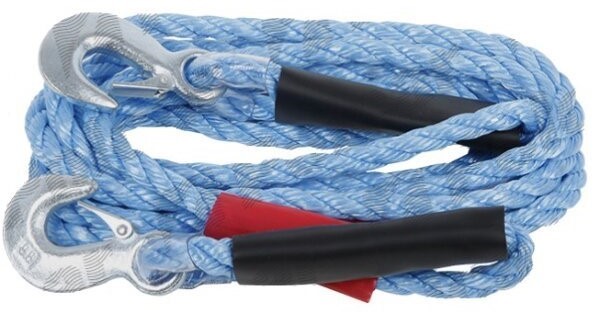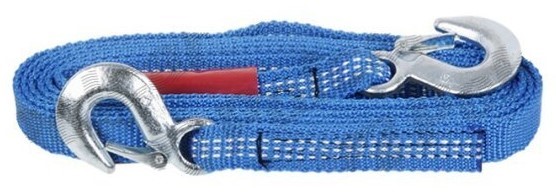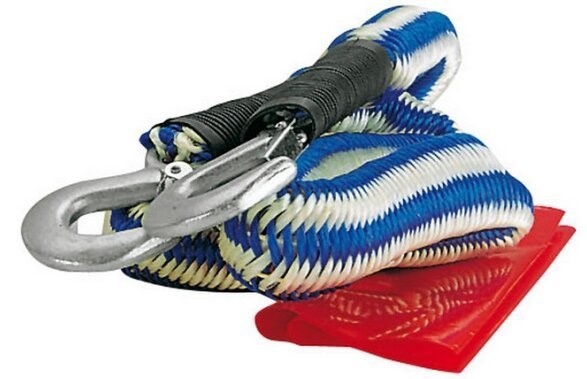There is a common misconception between recovery strap and tow rope and most of the time, these two are marketed as just the same products.
But, even if recovery and tow straps may look very similar, they have defining features and purposes that set them apart from each other.
The main difference between these two is that a tow strap features big metal hooks at both ends that are designed for hooking to the shackles and towing points. On the other hand, you cannot find these hooks in recovery straps.
Table of Contents
Key Differences between Recovery Straps and Tow Ropes
It is extremely important that you know the key differences between a recovery strap and a tow strap. This way, you can be sure that you will be getting the tool that is suitable for the specific job you have on hand.
As their names suggest, tow straps are specifically made for towing and must never be used for the purpose of recovery. Tow straps latch on to tow hooks and D-rings or shackles for pulling another vehicle.

The key reason why you should never use tow straps for recovery is that these don’t stretch. It means that there is a possibility that they will come undone or break off that can cause the connected hook to go flying off. It can be quite dangerous in certain instances and worse, it may even cause fatalities.
What makes recovery straps different is that their materials offer some elasticity that lets them stretch. It will be easy for you to identify these recovery straps because both of their ends feature loops that are attached to the frame or recovery points that are usually found on truck bumpers or under trucks.
The stretching property of recovery straps, however, is more important since these straps stretch to their capacity at first before pulling the car as it tries going back to the original condition. What is more important is that these straps don’t have any metal pieces or hooks attached to them and this makes them safe to use when they come undone by accident.
Simply put, it is best to use recovery straps for pulling out a stuck vehicle. A tow rope, on the other hand, must be used for towing a freely-moving car.
Things to Look for When Shopping for Recovery Straps or Tow Ropes
As stated earlier, elasticity is the most crucial factor you should look for when buying a recovery strap. You will want to ensure that the recovery strap can stretch without incurring any breakage. But, whether you are shopping at Silux webshop. for a recovery strap or a tow strap, you need to ensure that its width and length will be able to accommodate your specific needs.
After you have narrowed down your options according to the strap’s size, you should pay attention to the company’s advertised rating. Most of the time, it is the break strength capacity that it is not what is capable of towing. You should also know the strap’s vehicle rating that indicates what it can tow.
If you are buying a tow strap, you have to ensure that the hooks at both ends are actually made of top quality material. You wouldn’t want your hook to snap or break off just when you are trying to tow a car.
Another factor you should look into is durability because you would want to get a product that is waterproof and weather-resistant so that you can be sure that it will last for as long as possible. If ever you plan to use your recovery or tow strap often, see to it that it is built to last and durable, especially if you have plans to go off-road.
How to Use Recovery or Tow Straps Properly
Using a recovery or tow strap may sound simple and straightforward. However, doing things the wrong way may end up damaging your car, or worse, it may put a human life in danger. Your particular situation may require different steps but the following are the general guidelines you need to follow when using your recovery strap or tow rope.

1. See to it that the tow strap can tow your load.
Identify the actual payload weight the tow strap has been rated for before you attach it to a car. Check the strap carefully to ensure that it doesn’t have any tears that can make it weak.
2. Find the tow hook on the car you need to tow.
In general, you will find the tow hooks in front of the vehicle. At the back, you might find the receiver that the tow strap connects to. These are usually the only parts where you should hook up a car since doing it somewhere else might end up damaging the vehicle. If you don’t see any tow hook on the car, you can connect the strap to the frame of the vehicle. However, do it only if there are no other options left.
3. Connect the tow strap.
Connect the tow hook to the strap’s one end. If you are using a rope that features a loop at the tip, the loop should be threaded through the hook. You need to pull the rest of the strap through the loop. Check again to ensure that the open end of the hook faces downward to prevent it from accidentally getting unhooked.
4. Move the vehicle.
For the vehicle that will do the towing, you need to park it near the vehicle that will be towed. Attach the strap’s other end to it by following the above steps.
5. Put the vehicle being towed in neutral.
After you put the vehicle that will be towed in neutral position, ensure that there is someone in that car. Drive the other vehicle slowly and be extra careful if the strap has lots of slack. Prevent sudden movements that may damage the hooks, straps, and vehicles. If you experience too much resistance, check again to ensure that everything is hooked up properly and that you are using the correct strap suitable for the situation.
6. Be cautious when you come to a stop.
The vehicle that does the towing should slow down gradually and ensure that the person in the towed vehicle is ready to use the brakes as needed. If you will tow the car downhill, the driver in the vehicle must pay closer attention.
7. Remove all the hooks after you arrived at the destination.
After unhooking and removing the recovery strap or tow rope, you also need to remove all the accessories like the shackles. Keep the strap in a safe spot to keep it ready for future use.

